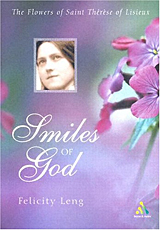"For Therese, flowers are metaphorical in the biblical sense. They are symbolic reflections of divine beauty and love, chalices of openness to the inpouring of God. They are human lives that come up, bud, bloom and have but a short time to live before they are cut down in fragile reliance on the vagaries of nature: on rain, drought, darkness and cold, and on wind and storm — all parts of a divine order. The individual flower that is Therese depends on the light of Jesus the Sun, but also on the earth where she is rooted and from which she springs: in other words, on her father and mother, and on her sisters and Sisters on God (often the same). This little flower is a wild flower of the fields tamed by the arrangement of the flower-bed and garden which God has designed for her nurture, so that she can rest in obscure readiness to serve and to please when she is seen or is offered as a mark of love. The holy Ground in which Therese locates herself as a flower may be her home or Carmel, earth as a whole or even the great expanses of the cosmos, but also the pastoral setting so often invoked in the Old and New Testaments.”
Smiles of God The Flowers of Saint Therese of Lisieux
Felicity Leng on St. Therese of Lisieux's take on the metaphor of flowers as openness to that which nourishes.
